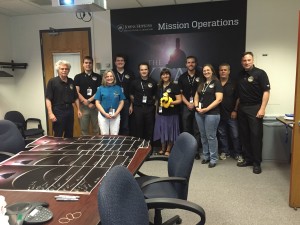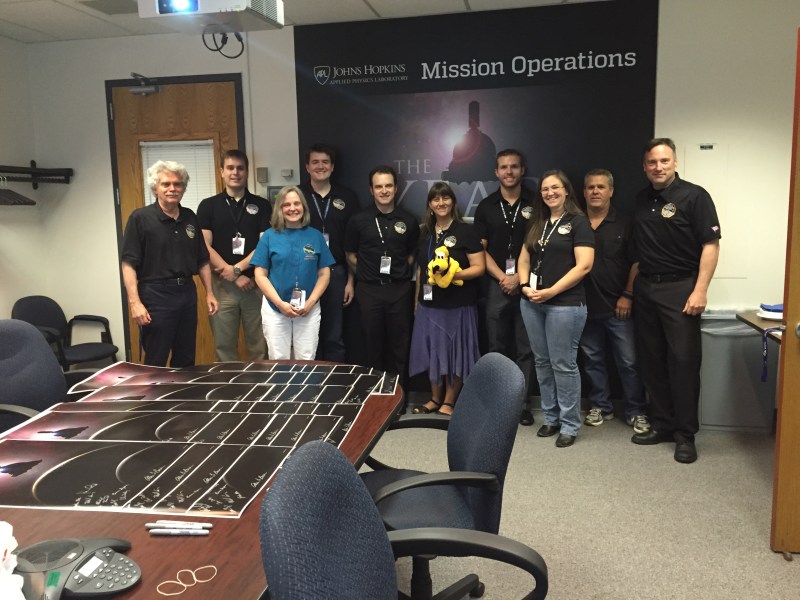
(Courtesy of Ivan Linscott)
After nine years in flight, NASA’s New Horizons spacecraft flew past Pluto on Tuesday, July 14, carrying with it Stanford-developed equipment. The landmark mission profiled Pluto and its moons and gathered data about their temperature and pressure conditions using a highly efficient radio occultation signal processing system created by Stanford scientists.
Stanford’s device is a compact firmware chip that employs a streamlined radio occultation process to profile the atmospheric temperature and the pressure of Pluto and its moons. Radio occultation is used in characterizing atmospheric conditions by gauging the change in radio signal as it is eclipsed by a target. Stanford’s device efficiently filters a broadband of information from the occultation to the spacecraft’s receiver. The receiver then relays a succinct band of information, called the REX (radio science experiment) band, to Earth for further analysis.
Early work with NASA
Stanford’s published expertise on radio occultation first attracted a partnership with NASA in 2000, and after six years of development, the chip was integrated into the spacecraft, which launched in 2006.
According to Stanford senior research associate in electrical engineering and co-investigator of the New Horizons mission Ivan Linscott, one of the most challenging aspects of the research was designing the chip within the strict parameters required for the spacecraft’s success.
“The problem we faced was this fairly complex task [that] had to be captured in a very tiny chip that consumed very little power and space and weight and volume,” Linscott said.
Despite multiple failed attempts to create a computationally efficient device, a breakthrough by graduate student Kamakshi Sivaramakrishnan Ph.D. ’08 used considerably less computing power and space through a more economical computer algorithm for in-flight data analysis. This development set the stage for the device’s later success.
“Before that discovery we were not likely to have succeeded in meeting our requirements for fitting the process into the spacecraft,” Linscott said.
Despite these initial complications, the implementation of the final device on the spacecraft and the periodic checkups during the nine-year mission went smoothly, according to Linscott.
Created by scientific demand
The motivation in uncovering Pluto’s atmospheric and surface properties stemmed from the planet’s enigmatic nature as an object of the Kuiper Belt. The Kuiper Belt is a collection of comets and icy objects that orbits the outskirts of the Milky Way solar system.
The New Horizons mission was inspired by feedback from NASA’s decadal survey. Every 10 years, NASA releases a survey that asks the planetary sciences community to prioritize scientific questions that should be answered.
In one of those surveys published in 2003, members of the community identified the exploration of Pluto and the Kuiper Belt objects as integral in understanding the formation of the solar system, according to Linscott. As a result, the New Horizons mission was born, and Stanford joined NASA and several other research institutions in working toward the goal of profiling Pluto.
Linscott believes that the information gathered not only by Stanford’s firmware chip but also by other instruments on the spacecraft will motivate a new wave of research advancements. Equipment onboard also included devices such as an imaging spectrophotometer and a state-of-the-art camera, and Linscott explained that these advancements could lead to a better understanding of space and the origins of the solar system.
Although New Horizons soared past Pluto on July 14, data will take anywhere from days to months to reach Earth due to the 4.67 billion miles separating the two planets – more than 50 times the Earth’s distance to the Sun. According to Linscott, a thermal scan of Pluto sent from Stanford’s device arrived on Wednesday, July 15, and the team expects data from Pluto’s occultation to come in on Saturday, July 18. The rest of the Stanford device’s REX information will trickle in over the next six months.
“There’s a richness to the data that comes down that’s going to contain many unsolved problems associated with the nature of the outer solar system,” Linscott said. “I fully expect that we will have a deep vein of academic opportunity in this coming decade.”
For now, scientists are eager to receive the information gathered by the spacecraft’s myriad of instruments, Linscott said.
“We don’t see this as an endgame,” Linscott said. “We want this [scientific progression] to flourish at Stanford, and there’s every reason to expect that.”
“We were pleased to have had that opportunity to be there,” he added. “It’s really been a privilege.”
Contact Alice Dai at alicettdai ‘at’ gmail.com.
